6 books by Hays-Gilpin, Kelley
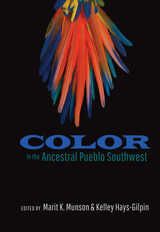
Color in the Ancestral Pueblo Southwest
Edited by Marit K. Munson and Kelley Hays-Gilpin
University of Utah Press, 2019
Color attracts attention, evokes emotions, conveys information, carries complex meanings, and makes things beautiful. Color is so meaningful, in fact, that research on the color choices of Ancestral Pueblo people has the potential to deepen our understanding of religious, social, and economic change in the ancient Southwest. This volume explores museum collections and more than a century of archaeological research to create the first systematic understanding of the many ways Ancestral Pueblo people chose specific colors through time and space to add meaning and visual appeal to their lives.
Beginning with the technical and practical concerns of acquiring pigments and using them to create paints, the authors explore how connections to landscapes and sacred places are embodied by many colorful materials. Contributors examine the development of polychromes and their juxtaposition with black-on-white vessels; document how color was used in rock paintings and architecture; and consider the inherent properties of materials, arguing that shell, minerals, and stone were valued not only for color but for other visual properties as well. The book concludes by considering the technological, economic, social, and ideological factors at play and demonstrates the significant role color played in aesthetic choices.
Beginning with the technical and practical concerns of acquiring pigments and using them to create paints, the authors explore how connections to landscapes and sacred places are embodied by many colorful materials. Contributors examine the development of polychromes and their juxtaposition with black-on-white vessels; document how color was used in rock paintings and architecture; and consider the inherent properties of materials, arguing that shell, minerals, and stone were valued not only for color but for other visual properties as well. The book concludes by considering the technological, economic, social, and ideological factors at play and demonstrates the significant role color played in aesthetic choices.
[more]
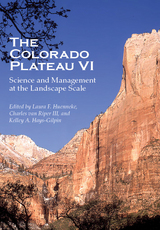
The Colorado Plateau VI
Science and Management at the Landscape Scale
Edited by Laura F. Huenneke, Charles van Riper III, and Kelley A. Hays-Gilpin
University of Arizona Press, 2015
Covering 130,000 square miles and a wide range of elevations from desert to alpine in Arizona, Utah, Colorado, and New Mexico, the Colorado Plateau has long fascinated researchers. The Colorado Plateau VI provides readers with a plethora of updates and insights into land conservation and management questions currently surrounding the region.
The Colorado Plateau VI’s contributors show how new technologies for monitoring, spatial analysis, restoration, and collaboration improve our understanding, management, and conservation of outcomes at the appropriate landscape scale for the Colorado Plateau. The volume’s chapters fall into five major themes: monitoring as a key tool for addressing management challenges, restoration approaches to improving ecosystem condition and function, collaboration and organizational innovations to achieve conservation and management objectives, landscape-scale approaches to understanding, and managing key species and ecological communities.
Focusing on the integration of science into resource management issues over the Colorado Plateau, this volume includes contributions from dozens of leading scholars of the region. The Colorado Plateau VI proves a valuable resource to all interested in the conservation management, natural history, and cultural biological resources of the Colorado Plateau.
The Colorado Plateau VI’s contributors show how new technologies for monitoring, spatial analysis, restoration, and collaboration improve our understanding, management, and conservation of outcomes at the appropriate landscape scale for the Colorado Plateau. The volume’s chapters fall into five major themes: monitoring as a key tool for addressing management challenges, restoration approaches to improving ecosystem condition and function, collaboration and organizational innovations to achieve conservation and management objectives, landscape-scale approaches to understanding, and managing key species and ecological communities.
Focusing on the integration of science into resource management issues over the Colorado Plateau, this volume includes contributions from dozens of leading scholars of the region. The Colorado Plateau VI proves a valuable resource to all interested in the conservation management, natural history, and cultural biological resources of the Colorado Plateau.
[more]
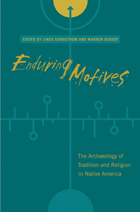
Enduring Motives
The Archaeology of Tradition and Religion in Native America
Linea Sundstrom
University of Alabama Press, 2012
Enduring Motives examines tradition and religious beliefs as they are expressed in landscape, the built environment, visual symbols, stories, and ritual.
Bringing together archaeologists and Native American experts, this volume focuses on long-lived religious traditions of the native peoples of the Americas and how religion codifies, justifies, and reinforces these traditions by placing a high value on continuity of beliefs and practice.
Using clues from the archaeological record to piece together the oldest religions of the Americas, Enduring Motives is organized into four parts. Part 1 creates continuity through structure, iconography, and sacred stories that correspond to culture-specific symbolic representations of the universe. Part 2 explores the encoding of tradition in place and object, or how people use objects to enliven tradition and pass it on to future generations. Part 3 examines stability and change and shows how traditions can evolve over time without losing their core cultural significance. The final part recognizes deep-time traditions through the evidence of ancient cosmology and religious tradition.
Spanning cultures as diverse as the Aztec, Plains Indians, Hopi, Mississippian, and Southwest Pueblo, Enduring Motives brings to light new insights on ancient religious beliefs, practices, methods, and techniques, which allow otherwise intangible facets of culture to be productively explored.
Contributors
Wesley Bernardini / James S. Brown Jr. / Cheryl Claassen / John E. Clark / ArleneColman / Warren DeBoer /
Wesley Bernardini / James S. Brown Jr. / Cheryl Claassen / John E. Clark / ArleneColman / Warren DeBoer /
Robert L. Hall /Kelley Hays-Gilpin / Alice Beck Kehoe /John E. Kelly / Stephen H. Lekson / ColinMcEwan /
John Norder / Jeffrey Quilter /Amy Roe / Peter G. Roe / Linea Sundstrom
[more]
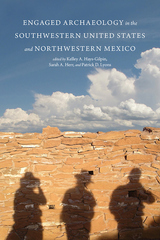
Engaged Archaeology in the Southwestern United States and Northwestern Mexico
Kelley A. Hays-Gilpin
University Press of Colorado, 2021
This volume of proceedings from the fifteenth biennial Southwest Symposium makes the case for engaged archaeology, an approach that considers scientific data and traditional Indigenous knowledge alongside archaeological theories and methodologies. Focusing on the southwestern United States and northwestern Mexico, the contributors show what can be gained when archaeologists engage with Indigenous communities and natural scientists: improved contemporary archaeological practice through better understandings of heritage and identity, anthropogenic landscapes, and societal potential for resilience.
Organized around the theme of interdisciplinary perspectives, the book highlights collaborations with those who have other ways of knowing the past, from the traditional and proprietary knowledge of communities to new scientific methods, and considers the social context of archaeological practice and the modern relationships that inform interpretations of the past. Chapters show how cutting-edge practices lead to new archaeological understandings when archaeologists work in partnership with descendant and stakeholder communities and across international and disciplinary borders. Authors work across anthropological subfields and with the sciences, demonstrating that anthropological archaeology’s methods are starting points for investigation that allow for the expansion of understanding by incorporating long-remembered histories with innovative analytic methods.
Engaged Archaeology in the Southwestern United States and Northwestern Mexico identifies current and near-future trends in archaeological practice in the US Southwest and northwestern Mexico, including repatriation, community engagement, and cross-disciplinary approaches, and focuses on Native American archaeologists and their communities, research, collaborations, and interests. It will be of interest to archaeologists and anthropologists working in the Southwest and to any researchers interested in interdisciplinary approaches to archaeology, heritage studies, and the natural sciences.
Contributors: Christopher Caseldine, Chip Colwell, Guillermo Córdova Tello, Patrick Cruz, T. J. Ferguson, Cécile R. Ganteaume, Vernelda Grant, Neysa Grider-Potter, Christopher Grivas, Michael Heilen, Jane H. Hill, Leigh J. Kuwanwisiwma, Teresita Majewski, Debra L. Martin, Estela Martínez Mora, John A. McClelland, Emiliano Ricardo Melgar Tísoc, Darsita R. North, Scott Ortman, Peter J. Pilles Jr., Susan Sekaquaptewa, Arleyn W. Simon, Kimberly Spurr, Sarah Striker, Kerry F. Thompson, John A. Ware, Peter M. Whiteley, Lisa C. Young
Organized around the theme of interdisciplinary perspectives, the book highlights collaborations with those who have other ways of knowing the past, from the traditional and proprietary knowledge of communities to new scientific methods, and considers the social context of archaeological practice and the modern relationships that inform interpretations of the past. Chapters show how cutting-edge practices lead to new archaeological understandings when archaeologists work in partnership with descendant and stakeholder communities and across international and disciplinary borders. Authors work across anthropological subfields and with the sciences, demonstrating that anthropological archaeology’s methods are starting points for investigation that allow for the expansion of understanding by incorporating long-remembered histories with innovative analytic methods.
Engaged Archaeology in the Southwestern United States and Northwestern Mexico identifies current and near-future trends in archaeological practice in the US Southwest and northwestern Mexico, including repatriation, community engagement, and cross-disciplinary approaches, and focuses on Native American archaeologists and their communities, research, collaborations, and interests. It will be of interest to archaeologists and anthropologists working in the Southwest and to any researchers interested in interdisciplinary approaches to archaeology, heritage studies, and the natural sciences.
Contributors: Christopher Caseldine, Chip Colwell, Guillermo Córdova Tello, Patrick Cruz, T. J. Ferguson, Cécile R. Ganteaume, Vernelda Grant, Neysa Grider-Potter, Christopher Grivas, Michael Heilen, Jane H. Hill, Leigh J. Kuwanwisiwma, Teresita Majewski, Debra L. Martin, Estela Martínez Mora, John A. McClelland, Emiliano Ricardo Melgar Tísoc, Darsita R. North, Scott Ortman, Peter J. Pilles Jr., Susan Sekaquaptewa, Arleyn W. Simon, Kimberly Spurr, Sarah Striker, Kerry F. Thompson, John A. Ware, Peter M. Whiteley, Lisa C. Young
[more]
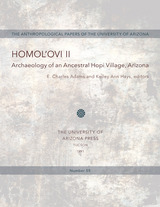
Homol'ovi II
Archaeology of an Ancestral Hopi Village, Arizona
Edited by E. Charles Adams and Kelley Ann Hays
University of Arizona Press, 1991
Homol'ovi II is a fourteenth-century, ancestral Hopi pueblo with over 700 rooms. Although known by archaeologists since 1896, no systematic excavations were conducted at the pueblo until 1984. This report summarizes the findings of the excavations by the Arizona State Museum of five rooms and an outside activity area, which now form the core of the interpretive program for Homolovi Ruins State Park. The significant findings reported here are that the excavated deposits date between A.D. 1340 and 1400; that nearly all the decorated ceramics during this period were imported from villages on the Hopi Mesas; that cotton was a principal crop which probably formed the basis of Homol'ovi II's participation in regional exchange; that chipped stone was a totally expedient technology in contrast to ground stone which was becoming more diverse; and that the katsina cult was probably present or developing at Homol'ovi II. These findings from the basis for future excavations that should broaden our knowledge of the developments taking place in fourteenth-century Pueblo society connecting the people whom archaeologists term the Anasazi with those calling themselves Hopi.
[more]
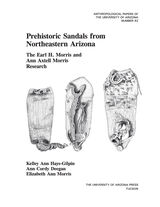
Prehistoric Sandals from Northeastern Arizona
The Earl H. Morris and Ann Axtell Morris Research
Kelley Ann Hays-Gilpin, Ann Cordy Deegan, and Elizabeth Ann Morris
University of Arizona Press, 1998
During the late 1920s and early 1930s, archaeologists Earl and Ann Axtell Morris discovered an abundance of sandals from the Basketmaker II and III through Pueblo III periods while excavating rockshelters in northeastern Arizona. These densely twined sandals made of yucca yarn were intricately crafted and elaborately decorated, and Earl Morris spent the next 25 years overseeing their analysis, description, and illustration. This is the first full published report on this unusual find, which remains one of the largest collections of sandals in Southwestern archaeology. This monograph offers an integrated archaeological and technical study of the footwear, providing for the first time a full-scale analysis of the complicated weave structures they represent. Following an account by anthropologist Elizabeth Ann Morris of her parents' research, textile authority Ann Cordy Deegan gives an overview of prehistoric Puebloan sandal types and of twined sandal construction techniques, revealing the subtleties distinguishing Basketmaker sandals of different time periods. Anthropologist Kelley Ann Hays-Gilpin then discusses the decoration of twined sandals and speculates on the purpose of such embellishment.
[more]
READERS
Browse our collection.
PUBLISHERS
See BiblioVault's publisher services.
STUDENT SERVICES
Files for college accessibility offices.
UChicago Accessibility Resources
home | accessibility | search | about | contact us
BiblioVault ® 2001 - 2024
The University of Chicago Press









